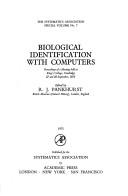| Listing 1 - 10 of 17 | << page >> |
Sort by
|
Book
ISBN: 0716719126 0716718855 9780716719120 Year: 1988 Publisher: New York Freeman
Abstract | Keywords | Export | Availability | Bookmark
 Loading...
Loading...Choose an application
- Reference Manager
- EndNote
- RefWorks (Direct export to RefWorks)
Biology --- Classification. --- SUR Systematic Surveys --- Monera = Prokaryotae --- Protoctista --- genera --- phyla --- systematic surveys --- Systematics. Taxonomy. Nomenclature --- Evolution. Phylogeny --- Classification --- #WPLT:syst --- Biosystematics --- Organisms --- Systematic biology --- Systematics (Biology) --- Taxonomy (Biology) --- Taxonomists --- zv systematics & taxonomy --- Biology - Classification. --- Biology. Classification --- Biology - Classification --- BIOLOGY --- CLASSIFICATION
Book
ISBN: 0306410613 1468442856 146844283X 9780306410611 Year: 1982 Publisher: New York, N.Y. Plenum Press
Abstract | Keywords | Export | Availability | Bookmark
 Loading...
Loading...Choose an application
- Reference Manager
- EndNote
- RefWorks (Direct export to RefWorks)
Evolution. Phylogeny --- Molecular biology --- Molecular evolution --- Macromolecules --- Biology --- Classification --- Macromolecules. --- Molecular evolution. --- Classification. --- Biology - Classification
Book
ISBN: 0435629840 9780435629847 Year: 1970 Publisher: London Heinemann
Abstract | Keywords | Export | Availability | Bookmark
 Loading...
Loading...Choose an application
- Reference Manager
- EndNote
- RefWorks (Direct export to RefWorks)
Biology --- Classification --- Systematics. Taxonomy. Nomenclature --- Classification. --- Biosystematics --- Organisms --- Systematic biology --- Systematics (Biology) --- Taxonomy (Biology) --- Taxonomists --- Biology - Classification

ISBN: 0801436753 9780801436758 Year: 2000 Publisher: Ithaca Cornell University Press
Abstract | Keywords | Export | Availability | Bookmark
 Loading...
Loading...Choose an application
- Reference Manager
- EndNote
- RefWorks (Direct export to RefWorks)
Biology --- SYS General Systematics --- biophilosophy --- cladistics --- conservation --- general systematics --- Biosystematics --- Organisms --- Systematic biology --- Systematics (Biology) --- Taxonomy (Biology) --- Taxonomists --- Biology - Classification
Book
ISBN: 0716712121 071671213X 9780716712121 Year: 1982 Publisher: San Francisco, Calif. Freeman
Abstract | Keywords | Export | Availability | Bookmark
 Loading...
Loading...Choose an application
- Reference Manager
- EndNote
- RefWorks (Direct export to RefWorks)
Systematics. Taxonomy. Nomenclature --- Evolution. Phylogeny --- Biology --- Biologie --- Classification --- zv systematics & taxonomy --- Classification. --- Biosystematics --- Organisms --- Systematic biology --- Systematics (Biology) --- Taxonomy (Biology) --- Taxonomists --- Biology - Classification

ISBN: 1282737325 9786612737329 0080920144 0123736218 9780123736215 9780080920146 071673026X 9780716730262 0716730278 0716731835 9780716730279 Year: 2009 Publisher: Amsterdam ; Boston : Academic Press/Elsevier,
Abstract | Keywords | Export | Availability | Bookmark
 Loading...
Loading...Choose an application
- Reference Manager
- EndNote
- RefWorks (Direct export to RefWorks)
Now published by Academic Press and revised from the author's previous Five Kingdoms 3rd edition, this extraordinary, all inclusive catalogue of the world's living organisms describes the diversity of the major groups, or phyla, of nature's most inclusive taxa. Developed after consultation with specialists, this modern classification scheme is consistent both with the fossil record and with recent molecular, morphological and metabolic data. Generously illustrated, now in full color, Kingdoms and Domains is remarkably easy to read. It accesses the full range of life forms that still inhabi
Biology --- Natural history --- Classification --- Biosystematics --- Organisms --- Systematic biology --- Systematics (Biology) --- Taxonomy (Biology) --- Taxonomists --- Classification. --- Phylogeny --- plants --- animals --- evolution. --- evolution --- classification. --- classification --- glossary --- Biology - Classification --- Prokarya --- Eukarya
Book
ISBN: 0262369966 026236218X 0262045273 9780262045278 Year: 2022 Publisher: Cambridge : The MIT Press,
Abstract | Keywords | Export | Availability | Bookmark
 Loading...
Loading...Choose an application
- Reference Manager
- EndNote
- RefWorks (Direct export to RefWorks)
How biodiversity classification, with its ranking of species, has social and political implications as well as implications for the field of information studies. The idea that species live in nature as pure and clear-cut named individuals is a fiction, as scientists well know. According to Robert D. Montoya, classifications are powerful mechanisms and we must better attend to the machinations of power inherent in them, as well as to how the effects of this power proliferate beyond the boundaries of their original intent. We must acknowledge the many ways our classifications are implicated in environmental, ecological, and social justice work -- and information specialists must play a role in updating our notions of what it means to classify. In Power of Position, Montoya shows how classifications are systems that relate one entity with other entities, requiring those who construct a system to value an entity's relative importance -- by way of its position -- within a system of other entities. These practices, says Montoya, are important ways of constituting and exerting power. Classification also has very real-world consequences. An animal classified as protected and endangered, for example, is protected by law. Montoya also discusses the Catalogue of Life, a new kind of composite classification that reconciles many local ("traditional") taxonomies, forming a unified taxonomic backbone structure for organizing biological data. Finally, he shows how the theories of information studies are applicable to realms far beyond those of biological classification.
Biology - Classification --- Life sciences - Classification --- Cladistic analysis --- Biodiversity --- Bibliographic & subject control --- Scientific nomenclature & classification --- Bibliographic and subject control --- Science: general issues --- Biodiversity. --- Biological diversification --- Biological diversity --- Biotic diversity --- Diversification, Biological --- Diversity, Biological --- Biology --- Biocomplexity --- Ecological heterogeneity --- Numbers of species

ISBN: 0125448503 9780125448505 Year: 1975 Volume: 7 Publisher: London Academic Press
Abstract | Keywords | Export | Availability | Bookmark
 Loading...
Loading...Choose an application
- Reference Manager
- EndNote
- RefWorks (Direct export to RefWorks)
Biomathematics. Biometry. Biostatistics --- Systematics. Taxonomy. Nomenclature --- Computer. Automation --- Biology --- Biological specimens --- Classification --- Data processing --- Congresses --- Identification --- -Biology --- -Life sciences --- Biomass --- Life (Biology) --- Natural history --- Specimens, Biological --- Biological products --- Biobanks --- -Data processing --- -Congresses --- Congresses. --- biological identification --- computer science --- determination --- methods --- symposium proceedings --- -Identification --- Life sciences --- Identification&delete& --- Data processing&delete& --- Classification&delete& --- Biology - Classification - Data processing - Congresses --- Biological specimens - Identification - Data processing - Congresses
Book
ISBN: 0081015143 0857099167 0857095013 1306771528 9780857099167 9780857095015 Year: 2014 Publisher: Sawston, England ; Waltham, Massachusetts ; Kidlington, United Kingdom : Elsevier,
Abstract | Keywords | Export | Availability | Bookmark
 Loading...
Loading...Choose an application
- Reference Manager
- EndNote
- RefWorks (Direct export to RefWorks)
Biological identification systems are a vital component in countering the threats to life and health posed by natural pathogens, toxins, and bioterrorism agents. It is essential that such systems are fast, accurate, reliable and easy to use. It is also important to employ the most suitable technology in dealing with any particular threat. This book provides a detailed review of the technologies available and the potential for future developments. Part one covers the essentials of DNA and RNA sequencing for the identification of pathogens, including next generation sequencing (NGS), p
Biological specimens -- Identification -- Data processing -- Congresses. --- Biology -- Classification -- Data processing -- Congresses. --- Biology. --- DNA --- Clinical Laboratory Techniques --- Nucleic Acids --- Investigative Techniques --- Nucleic Acids, Nucleotides, and Nucleosides --- Analytical, Diagnostic and Therapeutic Techniques and Equipment --- Chemicals and Drugs --- Methods --- Microbiological Techniques --- Human Anatomy & Physiology --- Earth & Environmental Sciences --- Health & Biological Sciences --- Animal Biochemistry --- Ecology --- Analysis --- Biology --- Biological specimens --- Classification --- Data processing --- Specimens, Biological --- Biological products --- Biobanks
Periodical
ISSN: 00397989 23301198 Year: 1952 Publisher: Washington, D.C.
Abstract | Keywords | Export | Availability | Bookmark
 Loading...
Loading...Choose an application
- Reference Manager
- EndNote
- RefWorks (Direct export to RefWorks)
Zoology --- Biology --- Biologie --- Zoologie --- Periodicals --- Classification --- Périodiques --- Animals --- #TS:WDEP --- 59 --- Life Sciences --- Zoölogie. Dierkunde --- 59 Zoölogie. Dierkunde --- 59 Zoology --- Périodiques --- EJBIOLO EPUB-ALPHA-S EPUB-PER-FT JSTOR-E --- Animals. --- Biology. --- Zoology. --- Periodicals. --- Natural history --- Life sciences --- Biomass --- Life (Biology) --- Animal kingdom --- Beasts --- Fauna --- Native animals --- Native fauna --- Wild animals --- Wildlife --- Organisms --- Human-animal relationships --- Biology - Classification - Periodicals --- Biology - Periodicals --- Animals - Classification - Periodicals --- Zoology - Periodicals --- Zoology - electronic journals
| Listing 1 - 10 of 17 | << page >> |
Sort by
|

 Search
Search Feedback
Feedback About UniCat
About UniCat  Help
Help News
News